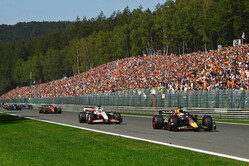


08/12/2022
NEWS STORY
 As he prepares to leave the sport, Ross Brawn admits to sharing the same view as many long-standing fans when it comes to DRS.
As he prepares to leave the sport, Ross Brawn admits to sharing the same view as many long-standing fans when it comes to DRS.
When DRS was first introduced in 2011 it was with the aim of giving a pursuing car an overtaking advantage at a time many were complaining about the lack of overtaking. (Weren't we always?).
However, from the outset there was doubt, for while fans wanted to see more overtaking - any overtaking at some tracks - some felt it made things too easy. Indeed, it was argued that the system totally disadvantaged the driver in front who had limited means of defending his position.
Among the critics was Juan Pablo Montoya, one of the sport's true 'hard men', who described DRS as "like giving Picasso Photoshop".
Since its introduction, the criticism has continued, especially as some tracks featured as many as three DRS zones, and earlier this year, despite the introduction of a raft of new rules aimed at improving the racing by allowing cars to follow more closely, commentators were still calling for DRS.
Indeed, it is planned that in 2023 at Sprint events, DRS will be available from the start of races rather than after a couple of laps, this being trialled ahead of a possible introduction at the Grand Prix in 2024.
At circuits like Spa-Francorchamps DRS has come close to making a mockery of the sport with a driver passing a rival in one zone only to lose the position in the next.
What started out as means of improving the racing by increasing the opportunity for overtaking has slowly had the opposite effect with DRS making it all too easy, leaving the onus on the defending driver.
As he prepares to leave the sport, Ross Brawn admits that the sport's powers that be have their doubts also.
"The one thing we know is fans, and we know this because we don't like it, they don't like the 'go down the straight, pop the DRS, overtake, drive fast, pull a gap' all of that," he tells Motorsport.com. "I think in an ideal world DRS is used just to get on the back of someone, so you can really have a decent attack."
The Briton believes that DRS zones should be where drivers can close in on a rival as opposed to being where drivers are virtually guaranteed a pass.
Citing this year's race in Melbourne, he says: "If you remember, they had four DRS zones and someone managed to persuade them to take one of them off, which was very annoying.
"Those DRS zones were not about overtaking there and then it was about getting on the back of someone to be able to attack them in the next complex. And that's the ideal world.
"I think we shouldn't be afraid to reduce the DRS in places like Monza, because it does seem a bit 'you get on the back of them, press the button, overtake'," he adds "It's a bit ritualistic, isn't it? It's not very impressive.
"So we shouldn't be afraid to reduce the use of DRS where it's clearly proving to be too powerful."
However, despite the rules overhaul, and his claims that they have improved the racing, Brawn admits that DRS remains a necessity.
"DRS is a useful tool where we want to get cars on the back of another one and them be able to get alongside in a corner and have a wheel-to-wheel battle.
"It's just judicious use of DRS," he adds. "That is what's needed. It will still be a tool we'll have to use. Maybe with active aerodynamics that will change."
Surely that was the point of the 2022 aero rules, wasn't it?